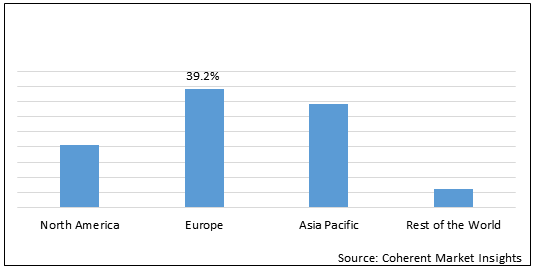Market Overview
Internet protocol television (IPTV) is the delivery of television content over internet protocol networks. This is different from conventional terrestrial, cable, and satellite television formats. IPTV offers the ability to stream the source media constantly. It delivers either stored video or live TV and is offered by the service providers. As IPTV delivers a video stream encoded as a series of IP packets, it enables the integration of PC, TV, home phone and wireless devices in order to offer these services anywhere and anytime. It can also be bundled with other IP services such as VoIP and high-speed Internet access.
The global IPTV market is estimated to account for US$ 269.9 Bn in terms of value by the end of 2027.
Market Dynamics- Drivers
The demand for value-added services such as high-definition (HD) and video-on-demand (VOD) is driving growth of the market. The pay-TV market including D2H service providers, cable service providers, and IPTV network service providers has witnessed a decrease in the average revenue per user (ARPU) as a result of providing standard definition services. As a result of this, key broadcasters have already shifted to HD channels and the trend is expected to continue in the near future. Since there is an increased demand for HD content globally, IPTV providers are enhancing their HD offerings, in order to increase their market presence. For instance, IPTV service providers such as AT&T, Verizon, and SureWest, along with the cable video service providers such as Comcast, Time Warner, and Cablevision in the U.S. are in a fierce race to increase their customer base. Hence, these factors are expected to drive growth of the global IPTV market during the forecast period.
Internet video advertising has gained significant traction in the market. It offers a broader and more expansive platform for business owners to market their products and services. Besides, it is more sophisticated and cost-efficient than conventional modes of advertising and marketing. Numerous brands in the market are opting for internet video advertising, in order to promote their products. Therefore, these factors are expected to propel the global IPTV market growth over the forecast period.
Statistics:
Europe held dominant position in the global IPTV market in 2019, accounting for 39.2% share in terms of value, followed by APAC, North America and RoW respectively.
Figure 1: Global IPTV Market Share (%), in terms of Value, By Region, 2019

To learn more about this report, Download Free Sample
Market Dynamics- Restraint
There is a strong competition offered by cable TV and satellite TV operators in emerging economies. Growth of IPTV is typically dependent upon broadband subscriptions. Although IPTV offers additional advantages such as interactive service and superior quality, it can only be deployed in the households that have a provision for a broadband connection. Furthermore, in emerging economies such as India with low internet penetration, the acceptance of IPTV is still at the nascent stage. Lack of awareness regarding the features offered by IPTV such as edutainment and interactivity is the prime reason behind its low popularity in the country.
Many emerging economies are far behind in terms of broadband networks. The challenges faced during the provisioning of IPTV service impact the entire service channel, right from the consumers to service providers. For instance, consumers wishing to switch their TV service from cable to a telco’s bundle of voice, IPTV, and data face multiple challenges such as low bandwidth, or absence of the requisite IP functionality or backplane capacity with the existing infrastructure. Currently, the most critical requirement for IPTV is the availability of requisite infrastructure. IPTV requires high-quality broadband connections which are still not supported in many emerging regions. Thus, these factors are expected to hinder the global IPTV market growth in the near future.
IPTV Market Report Coverage
| Report Coverage | Details | ||
|---|---|---|---|
| Base Year: | 2019 | Market Size in 2019: | US$ 67.0 Bn |
| Historical Data for: | 2016 to 2019 | Forecast Period: | 2020 to 2027 |
| Forecast Period 2020 to 2027 CAGR: | 19.0% | 2027 Value Projection: | US$ 269.9 Bn |
| Geographies covered: |
|
||
| Segments covered: |
|
||
| Companies covered: |
AT&T, Inc., ARRIS Group, Inc., Bharti Airtel Limited, MatrixStream Technologies, Inc., CenturyLink, Inc., Amino Technologies plc, Deutsche Telekom AG, Orange SA, Cisco Systems, Inc., and Broadcom Corporation. |
||
| Growth Drivers: |
|
||
| Restraints & Challenges: |
|
||
Uncover macros and micros vetted on 75+ parameters: Get instant access to report
Market Opportunities
Geriatric population, i.e. people aged 55 years and above spend the maximum number of hours watching TV among all age groups globally. According to the Television Bureau of Canada, viewers aged 55 years and above watch more television than any other age group. However, elderly people often face challenges with the new technology and tend to avoid it due to its complexity. Although the integration of social networking sites with IPTV fulfills many leisure-time requirements and expectations, the elderly population finds it challenging to operate or access the same. Acknowledging the existence of this technology gap between the generations, certain research universities are working on reducing the complexities associated with it in order to help the end-user adapt to new technologies such as IPTV and social networking sites with minimal effort. For instance, the researchers are working on a system to integrate IPTV with social networking websites such as Twitter using a mobile phone.
Many telcos consider the increase in demand for OTT as a restraint for growth of the IPTV market with the belief that OTT would change their role in the pay-TV market and hence, cannibalize IPTV revenues. However, the market scenario is changing fast and some operators are already trying to exploit the potential opportunity associated with OTT in order to boost IPTV revenue. OTT is serving as a motivation for the pay-TV market by pushing the telcos to improve their IPTV services with multi-screens. Operators are increasingly entering into non-managed OTT environments alongside their managed IPTV services, and are using the open internet to offer video services to any potential customer within the connectivity perimeter of their broadband network, irrespective of whether they are an existing customer or not.
Figure 2: Global IPTV Market Value (US$ Bn), 2017 - 2027

To learn more about this report, Download Free Sample
The global IPTV market was valued at US$ 67.0 Bn in 2019 and is forecast to reach a value of US$ 269.9 Bn by 2027 at a CAGR of 19.0% between 2020 and 2027.
Market Trends
IPTV service providers have started offering additional services to pure-play IPTV services. These services include social networking, multi-screen viewing, and content discovery & recommendation services, in order to expand their revenues. According to Coherent Market Insights’ analysis, 80% of the IPTV providers are expected to offer multi-video services by the end of 2015. IPTV providers are also using middleware solutions as it enables them to reduce their video management and delivery costs while storing more content and feeding additional IP-connected devices at the same time.
IPTV providers are offering triple-play services, which allow users to experience broadband, telephone, and TV services on a single line. These IPTV providers are also offering mobility to the customers along with triple-play services, in order to increase the market growth of IPTV as against satellite TV and cable TV. This, in turn, allows the customers to utilize IPTV services on a multi-viewing experience. Furthermore, Twitter and Facebook apps read a viewer’s incoming tweets or status updates and present these on the TV screen along with television programming and commercials. Therefore, the advertisers are carefully aiming to exploit these services being offered by the IPTV providers.
The value chain of the IPTV market is initiated by the hardware systems or equipment providers that provide hardware systems or equipment to the telecommunication operators for the purpose of offering IPTV services to the consumers. Hardware equipment for IPTV includes: integrated digital head-end platforms, IP video encoders, streaming and VoD content servers, IPTV middleware/content delivery platforms, and IP set-top boxes. Alcatel-Lucent is one of the leading IPTV equipment providers
Global IPTV Market - Impact of Coronavirus (Covid-19) Pandemic
Due to Covid-19 pandemic, many industries witnessed significant shift in their business. Every country has announced lockdown to contain the spread of coronavirus. As people are staying at home and curious to know more updates on coronavirus has increased the demand for the news channel. For instance, in April 2020, according to Broadcast Audience Research Council (BARC), total TV viewership increased to 21% from 7%, as most of the people watched news channel to get updates of the COVID-19. Streaming services such as Netflix, Amazon Prime Video, and Zee5 are used by people for entertainment which increased the pressure on networks. Due to the rising demand for high network connectivity the demand for global IPTV market increased.
Competitive Section
Major companies operating in the global IPTV market are AT&T, Inc., ARRIS Group, Inc., Bharti Airtel Limited, MatrixStream Technologies, Inc., CenturyLink, Inc., Amino Technologies plc, Deutsche Telekom AG, Orange SA, Cisco Systems, Inc., and Broadcom Corporation.
Key Developments
Share
Share
Missing comfort of reading report in your local language? Find your preferred language :
Transform your Strategy with Exclusive Trending Reports :
Frequently Asked Questions
Select a License Type
Joining thousands of companies around the world committed to making the Excellent Business Solutions.
View All Our Clients